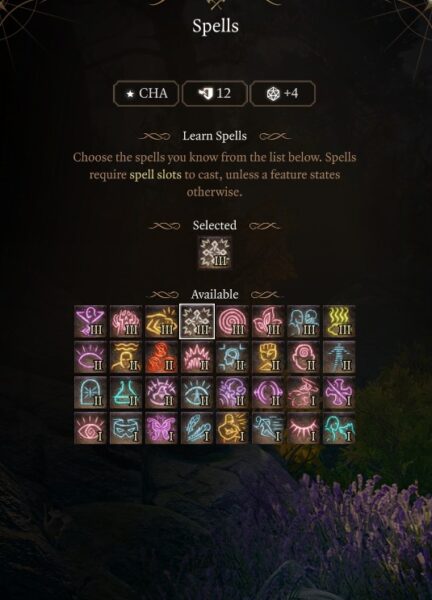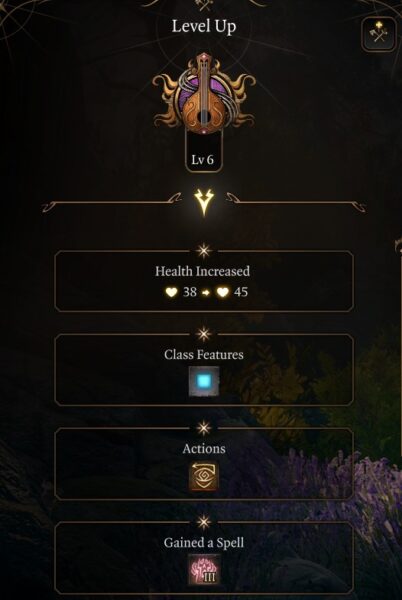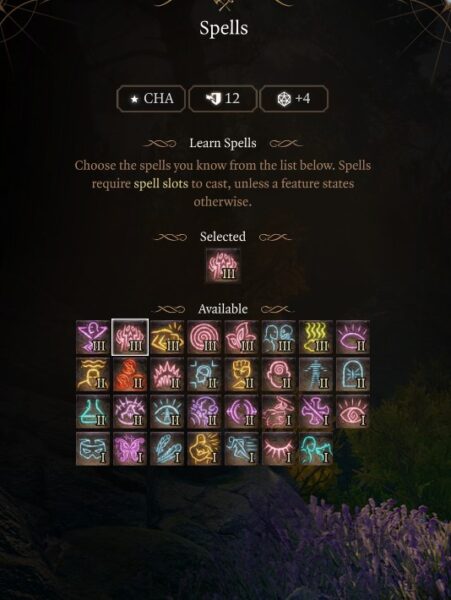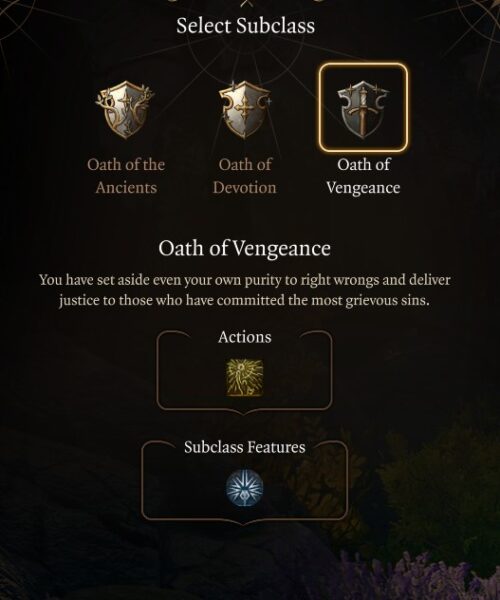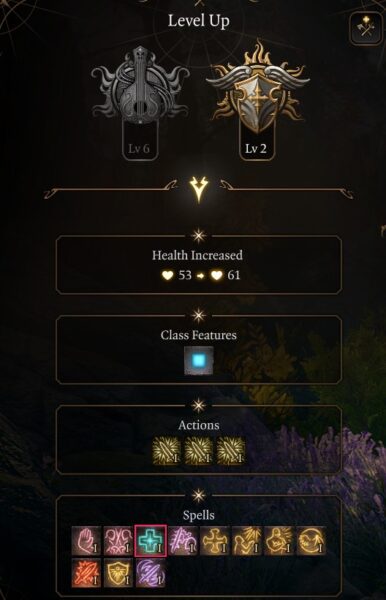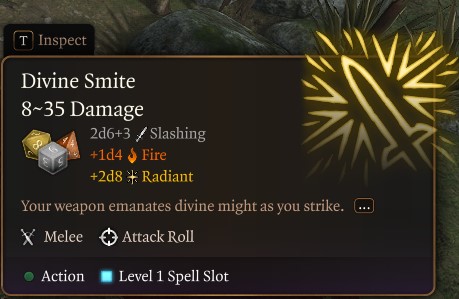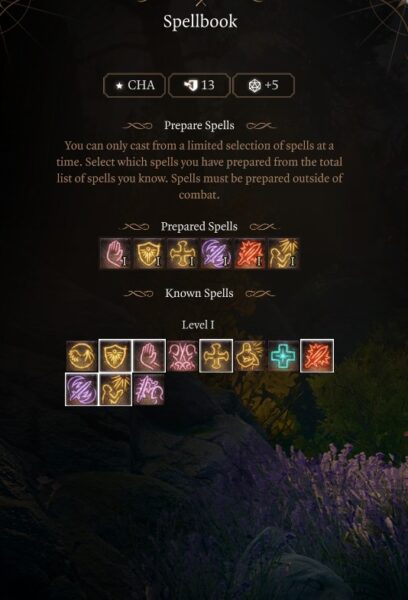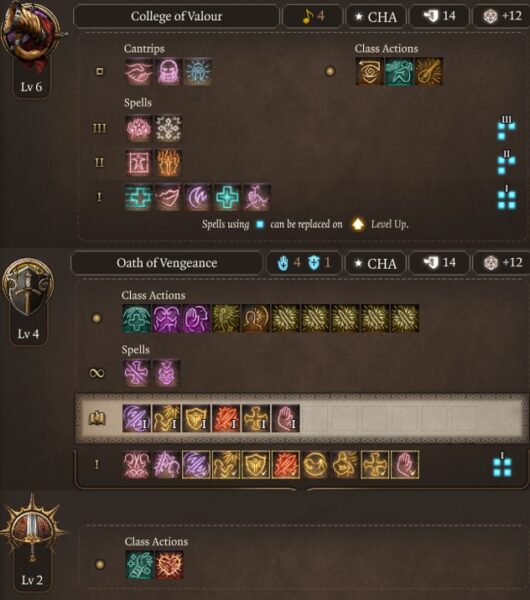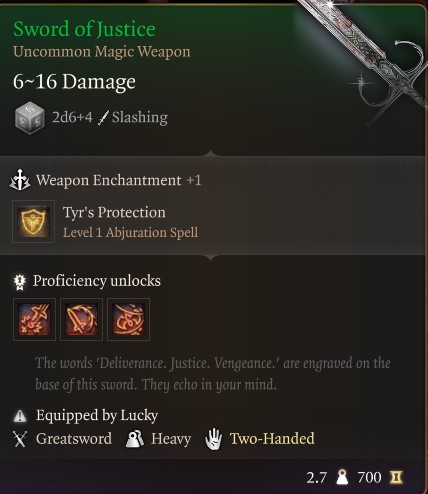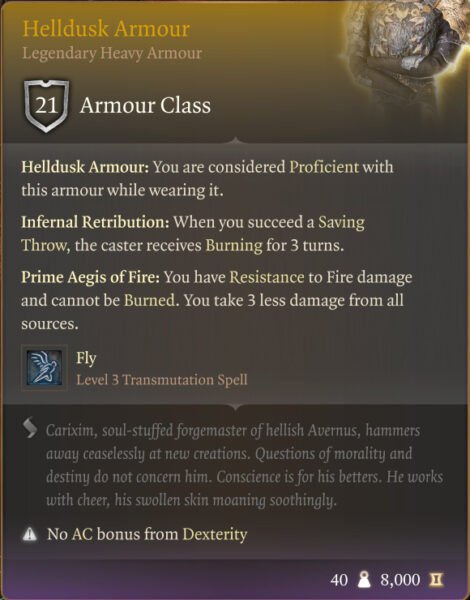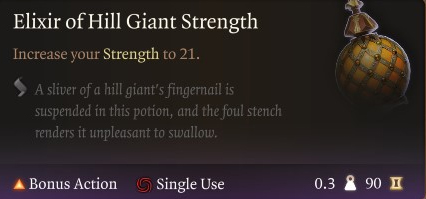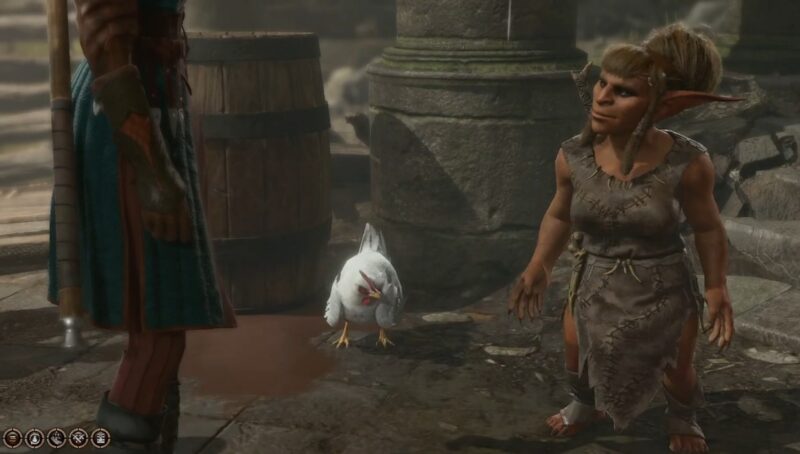This guide focuses on the Multiclass Bard in Baldur’s Gate 3 (BG3), combined with the Paladin and Fighter classes, to create a powerful build.

This build page has been updated for the Patch 8 version of Baldur’s Gate 3.
Everything About the Multiclass Bard in Baldur’s Gate 3
Our Multiclass Bard build in Baldur’s Gate 3 will start with the College of Valour subclass, and then add levels from both the Paladin and Fighter classes as you progress. The Bard College of Valour subclass provides Extra Attack and Martial weapons, giving the Bard powerful two-handed Greatsword proficiency.
Next combine martial weapons, and an extra attack with Paladin Divine Smite for extra damage, and your Bard build will do high damage. Finally, levels in the Fighter class will unlock Action Surge. Consequently, at end game your Bard build will get a second action during one turn. Play this build if you want something different, powerful, with high damage potential for your Bard build in BG3.
The Bard class in Baldur’s Gate 3 are the masters of music and performance in Baldur’s Gate 3. They have access to a wide range of spells, from powerful damage dealing to versatile utility spells. Bards are known for their iconic Bardic Inspiration skill, which enhances allies’ capabilities in combat or during exploration.
Patch 8 Changes to Multiclass Bard Build for BG3

The most significant change that Patch 8 brought to the multiclass Bard in BG3 is the addition of the College of Glamour subclass and the Booming Blade cantrip. The College of Glamour subclass is a good choice if you are looking for a support build that is also highly effective at dialogue and persuasion.
However, while the Bard class does not have access to the Booming Blade cantrip, you can create a highly effective multiclass build by taking a level in Warlock. Furthermore, you can combine it with the Fighter in later levels to produce an incredibly powerful melee character. In the Leveling Progression section below, we’ll outline an alternative build that features this hybrid playstyle.
Multiclass Bard Build Features
The following list presents all the essential Multiclass Bard/Paladin/Fighter Build Mechanics and Features in Baldur’s Gate 3:
- Primary Ability: Charisma
- Saving Throws: Charisma and Dexterity
- Armour Proficiency: Light Armor, Medium Armor, Shields
- Weapon Proficiency: Simple Weapons, Martial Weapons
- College of Valour Subclass: Gain Combat Inspiration and Extra Attack.
- Song of Rest: essentially a Bard spell providing a short rest for your group.
- Combat Inspiration: add a +1d6 bonus to their next Attack Roll, Ability Check, or Saving Throw.
- Extra Attack: You can make an additional free attack after making an unarmed or weapon attack.
- Oath of Vengeance Subclass: specializes in single target damage and mobility.
- Channeled Oath Charges: Paladin-specific resource that allows the casting of spells and abilities.
- Divine Smite: Expend spell slots to deal additional radiant damage on a successful melee attack.
- Inquisitor’s Might: You or an ally’s weapon attacks deal additional Radiant damage equal to your charisma modifier.
- Fighter Class: prototypical melee damage dealer.
- Second Wind: Heal yourself with a bonus action, and gain access to this at level 1.
- Action Surge: Gain one additional action, acquired at level 2.
- Great Weapon Fighting: When you roll a 1 or 2 on a damage die for an attack with a Two-Handed melee weapon, that die is rerolled once.
Multiclassing Explained
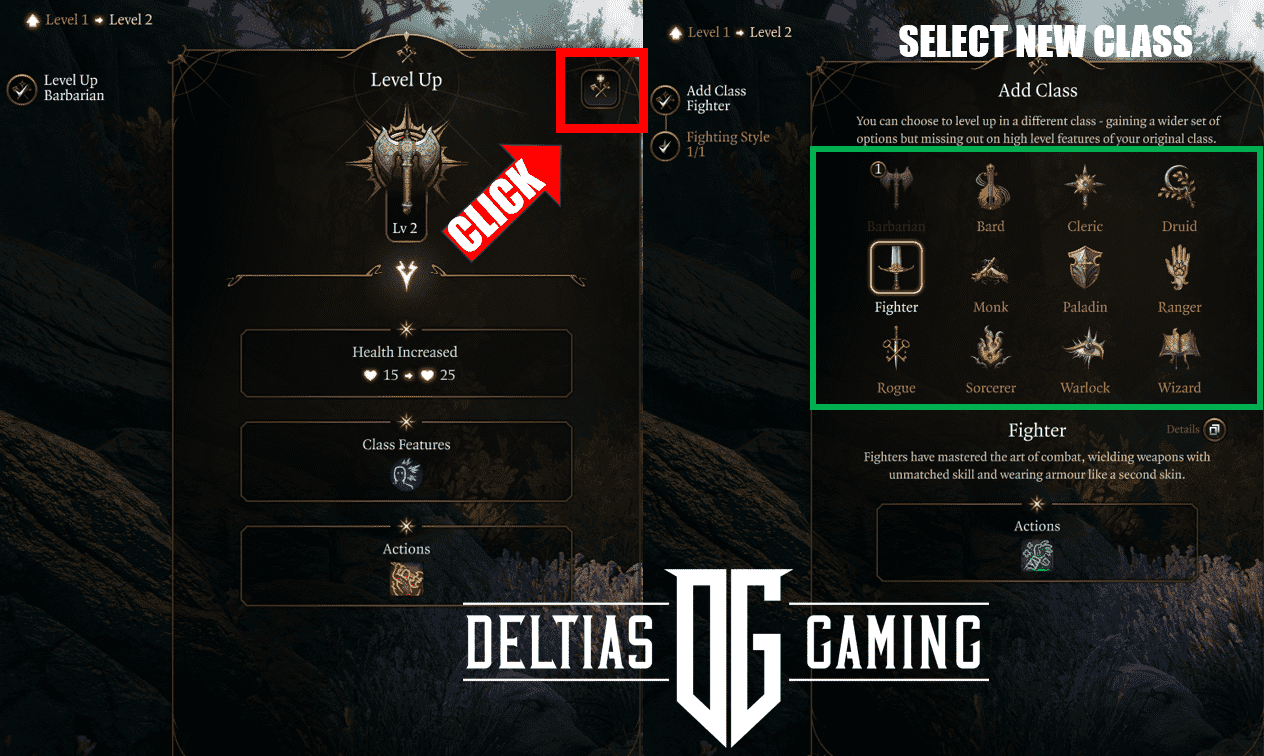
Multiclassing in Baldur’s Gate 3 allows your character to gain a level in a new class instead of advancing in their current class. To Multiclass in BG3, hit the top right plus button to add a class, so that it will bring up a new screen with the other classes in Baldur’s Gate 3.
Multiclassing grants most of the benefits of that new class, but there are some limitations. Your multiclassing character does not receive all the proficiencies of their new class. You also cannot multiclass when playing on Explorer Difficult.
Below is a list of Multiclass Proficiencies gained by taking one level in a new class:
| Class | Gained Proficiency |
|---|---|
| Barbarian | Shields, Simple Weapons, Martial Weapons |
| Bard | Light Armor, One skill, One instrument |
| Cleric | Light Armor, Medium Armor, Shields, Morningstars |
| Druid | Light Armor, Medium Armor, Shields |
| Fighter | Light Armor, Medium Armor, Shields, Simple Weapons, Martial Weapons |
| Monk | Simple Weapons, Shortswords |
| Paladin | Light Armor, Medium Armor, Shields, Simple Weapons, Martial Weapons |
| Ranger | Light Armor, Medium Armor, Shields, Simple Weapons, Martial Weapons, One skill |
| Rogue | Light Armor, One skill |
| Sorcerer | – |
| Warlock | Light armor, Simple Weapons |
| Wizard | – |
Best Bard Multiclass
The best class for the Bard to multiclass into is the Paladin because you gain a Fighting Style, Divine Smite, and additional spells. A secondary multiclass choice for the Bard is the Fighter because you can get Action Surge, Fighting Style, and Second Wind.
Here is the best multiclass choice for a Bard build in Baldur’s Gate 3:
| Paladin | Fighter |
|---|---|
| Additional Spells | Action Surge |
| Fighting Style | Fighting Style |
| Divine Smite | Second Wind |
For this build, we recommend 6 levels into Bard, 4 levels into Paladin, and 2 levels into Fighter. With 6 levels into the Bard, you will unlock many powerful crowd control skills and Extra Attack. With 4 levels into Paladin, you unlock Divine Smite, spells, and a feat. Two levels of investment into Fighter will give you an additional Fighting Style and Action Surge.
We will start with 6 levels into Bard first to unlock Extra Attack and a feat. Extra Attack class passives do not stack, meaning if you take 5 levels of Paladin, which contains Extra Attack, you won’t receive any benefit. This is why you want to rush to get Extra Attack unlocked for a melee build, and then swap to other classes. Follow along below in the leveling progression for the Best Baldur’s Gate 3 Multiclass Bard Build.
Character Creation
Best Race for Multiclass Bard

Half-Orc is the Best Race Choice for a multiclass Bard Build because Savage Attacks allows you to roll an additional die on critical hits with melee weapons. Relentless Endurance also prevents you from being Downed per long rest making a great defensive and offensive racial choice. However, a secondary choice is the Zariel Tiefling because of their two free Divine Smite spells, Darkvision, and fire resistance. This will help provide melee damage spells early before multiclassing to the Paladin.
Here is the best race choice for a multiclass Bard build in Baldur’s Gate 3:
Best Background for Multiclass Bard
The best Background for a Bard Multiclass Build is Entertainer because it has proficiency in Acrobatics and Performance. Backgrounds in Baldur’s Gate 3 are a way to represent your character’s backstory and give them some starting skills and abilities.
Best Ability Score for Multiclass Bard
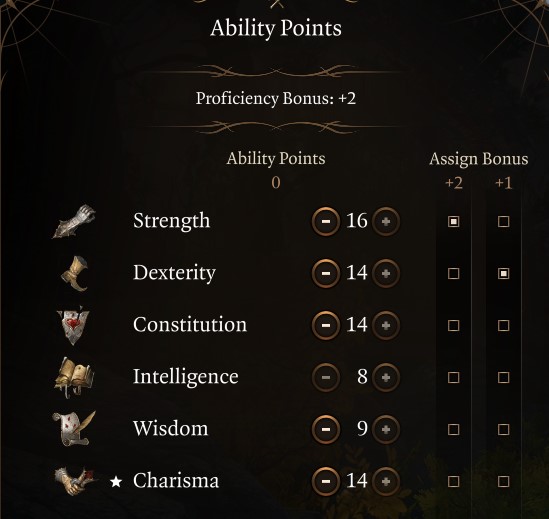
The Best Ability Score for multiclass Bard Build is 16 Strength, 14 Dexterity, and 14 Charisma. Strength is used for melee attack rolls, Dexterity increases your AC and helps go earlier in combat, while Charisma is used for spell casting. This will give you a good blend of offensive damage with melee weapons, spell-casting precision, and survivability.
Below is the best ability score for a multiclass Bard in Baldur’s Gate 3:
- Strength – 16
- Dexterity – 14
- Constitution – 14
- Intelligence – 8
- Wisdom – 9
- Charisma – 14
Best Skills for Multiclass Bard
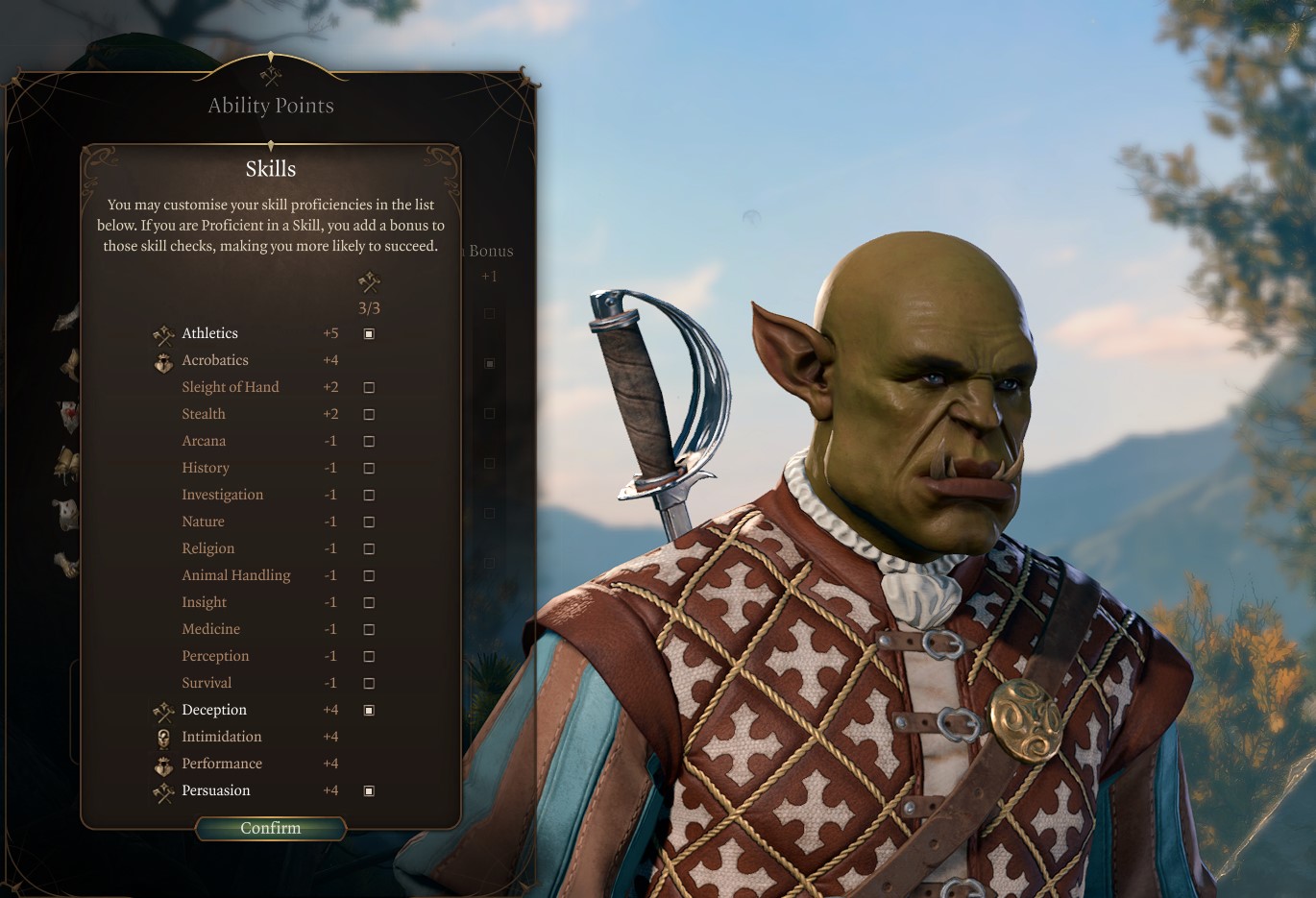
Deception, Athletics, and Persuasion are the best skills for the multiclass Bard because they complement your build when exploring the environment.
Best Companions for Multiclass Bard
The best companions for a Bard Multiclass build in BG3 are Shadowheart, Gale, and Astarion. This will give you a balanced team with a Cleric for support, Gale for area damage, and a Rogue for ranged damage, and utility.
- Shadowheart (Cleric): buffs, healing, and crowd control.
- Gale (Wizard): range magic damage, area damage, and crowd control.
- Astarion (Rogue): range damage, lockpicking, and utility.
Related:
Best Multiclass Bard Build – Level Progression in Baldur’s Gate 3
| Level | Class | Selection |
|---|---|---|
| 1 | Bard | Cantrips: Vicious Mockery, Light Spells: Tasha’s Hideous Laughter, Thunderwave, Cure Wounds, Healing Word |
| 2 | Bard | Dissonant Whisper |
| 3 | Bard | Subclass: Valour Spell: Heat Metal |
| 4 | Bard | Cantrip: Friends Spell: Hold Person Feat: +2 Strength |
| 5 | Bard | Glyph of Warding |
| 6 | Bard | Fear |
| 7 | Paladin | Subclass: Oath of Vengeance |
| 8 | Paladin | Great Weapon Fighting Style, Bless, Command, Thunderous Smite |
| 9 | Paladin | Searing Smite |
| 10 | Paladin | Divine Favour, Feat: +2 Strength |
| 11 | Fighter | Defence Fighting Style |
| 12 | Fighter | Action Surge |
Alternative Multiclass Bard Build
For this alternative College of Glamour Bard build, you’ll start at Level 1 with Warlock, choosing the Hexblade subclass. This gives you access to Eldritch Blast and Booming Blade, two powerful cantrips that set the stage for a hybrid melee-magic playstyle. At Level 2, stay in Warlock to gain Hellish Rebuke and a couple of Eldritch Invocations, providing both damage and utility.
At Level 3, you’ll multiclass into Bard and pick up your subclass at Level 5. College of Swords is the ideal choice for this build, as it complements a melee-focused playstyle, boosting your effectiveness in combat. Finally, finish off with Fighter and the Eldritch Knight subclass, adding even more spellcasting options and martial damage potential to your character.
| Level | Class | Selection |
|---|---|---|
| 1 | Warlock | Subclass: Hexblade, Eldritch Blast, Booming Blade, Hex, Wrathful Smite |
| 2 | Warlock | Hellish Rebuke, Eldritch Invocations: Devil’s Sight and One with Shadows |
| 3 | Bard | Multiclass: Bard, Vicious Mockery, Friends, Longstrider, Speak with Animals, Tasha’s Hideous Laughter, Charm Person |
| 4 | Bard | Thunderwave Spell |
| 5 | Bard | College of Swords subclass, Duelling fight style, Invisibility spell |
| 6 | Bard | Mage Hand cantrip, Heat Metal spell, Feat: +2 Charisma |
| 7 | Bard | Glyph of Warding spell |
| 8 | Bard | Fear spell, replace Heat Metal with Hold Person |
| 9 | Fighter | Multiclass: Fighter, Defence Fighting Style |
| 10 | Fighter | Action Surge |
| 11 | Fighter | Subclass: Eldritch Knight, Chromatic Orb, Magic Missile spells, Bursting Sinew, Fire Bolt cantrips, Shield extended |
| 12 | Fighter | Feat: Alert, Protection from Good and Evil |
Level 1

Follow our character creator to pick all correct background, race, skills, and ability scores focusing on Strength, Dexterity, and Charisma. For this Bard Multiclass build, we will be using Martial Weapons starting at level 3 where you can pick your subclass. College of Valour will unlock Martial Weapon proficiency alongside medium armour. Then this build switches to Paladin at level 7 to gain Divine Smite and increase our melee damage potential. Finally, you pick up two levels of Fighter to gain Action Surge, giving you a once-per-short rest additional action.
Your goal is to reach level 3, where then the build, weapon, and armour options become plentiful. At level 3, you will then use Medium Armour and a two-handed Greatsword with melee damage. Expect a big boost in combat performance at levels 3 and 6, while the other levels can feel lackluster. Two powerful weapons in Act 1 are the Sword of Justice and the Silver Sword. You can grab medium armor from Lae’zel in the introduction if you don’t plan on using her. Then look to access the Hollowed City at the north of the starting spot post tutorial where Dammon and others will sell good armor. Below we will walk you through the leveling progression when using the Best Baldur’s Gate 3 Multiclass Bard Build.
Cantrip Selection
- Vicious Mockery: Insult a creature: it has Disadvantage on its next Attack Roll.
- Light: Infuse an object with an aura of light. Lasts until Long Rest.
Spell Selection
- Tasha’s Hideous Laughter: Leave a creature Prone to laughter, without the ability to get up.
- Thunderwave: Release a wave of thunderous force that pushes away all creatures and objects.
- Cure Wounds: Heal a creature you can touch.
- Healing Word: Heal a creature you can see.
The early spells for the Bard are somewhat weak in comparison to other classes, especially without a subclass unlocked. Tasha’s Hideous Laughter is your crowd control to knock an enemy prone and “stun” them. Thunderwave is a helpful knockback that can be used to instantly kill enemies off ledges. Cure Wounds and Healing Word are powerful healing spells early on. While you won’t be focusing on support or healing, it’s helpful to have these unlocked early on.
You won’t have marital weapons unlocked at this level but can use Rapiers and Longswords with Hand Crossbows. Look for Rapier +1 in Hollow City or a shortsword through the tutorial and use weapon attacks for damage, not spells. Level 3 will increase options and power so work towards progressing.
Also Check:- BG3 Interactive Map
Multiclass Bard Gameplay & Priorities
During the early phase of BG3, the Bard should equip a Shortsword or Longsword and a Light Crossbow or Shortbow. As you pick your subclass at level 3, you will then unlock more weapon and armour options. Although the traditional Bard focuses on utility and buff spells, this multiclass build will allow for a more marital build. Moreover, look to acquire Elixir of Hill Giant Strength, Potion of Speed, and Oil of Accuracy consumables. These three consumables “stack” allowing for massive damage and your Multiclass Bard will feel very powerful immediately.
Your overall priority with the Multiclass Bard build is the following:
- Complete Prologue
- Recruit Companions
- Reached Hollowed City/Druid Grove
- Sell, Stock up, complete quest
- Unlock Withers, respec companions if needed
- Progress to level 5
- Reach Underdark and Grymforge
Following these steps ensures a strong foundation for her especially if you plan on playing solo or on Honour Mode difficulty.
Bard Multiclass Level 1 Spells: Tasha’s Hideous Laughter, Thunderwave, Cure Wounds, and Healing Word.
Level 2
At level 2, the Bard unlocks a class feature, more spell slots, and another learned spell. Below is our recommendation for level 2:
- Jack of All Trades (class feature): Your vast experiences make you more likely to succeed in any undertaking. Add half of your Proficiency Bonus (rounded down) to Ability Checks that you are not Proficient in.
- Song of Rest (class action): You and your allies are revitalized like you would have taken a Short Rest.
- Dissonant Whisper (spell selection): Frighten a creature: it will be easier to hit and cannot move.
At this level, you get some utility features and spells. Jack of All Trades it exploration focus and helps with non-combat situations. Song of Rest acts as a free short rest keeping you from having to use healing potions or spells to recover. Dissonant Whisper is a ranged immobilization spell that also does damage. Next level you can finally unlock your subclass and work towards feeling like a unique Bard build.
Bard Multiclass Level 2 Spells: Tasha’s Hideous Laughter, Thunderwave, Cure Wounds, Healing Word, and Dissonant Whisper.
Level 3
At level 3, the Bard can choose their subclass. You will also learn one new spell. Below are our suggestions for level 3 Bard:
- College of Valour Subclass:
- Martial Weapons, Medium Armour, and Shield Proficiency
- Skill Selection: Deception and Persuasion
- Combat Inspiration (subclass feature): Inspire an ally to add a +1d6 bonus to their next Attack Roll, Ability Check. Saving Throw, weapon damage, or Armour Class.
- Heat Metal (spell selection): Cause a metal weapon or armour to glow red-hot and force the creature touching it to let go or receive Disadvantage on Attack Rolls and Ability Checks.

Choosing the College of Valour Subclass
The core feature of the College of Valour subclass is Combat inspiration. This can only be used on allies and consumes a charge of Bardic Inspiration and a bonus action. The inspiration only lasts until consumed by giving a +1d6 bonus to Ability check, saving through, armour class, Attack Roll, or Weapon attack damage. You can check this bonus in the reaction tab and mark “ask” which can help prevent you from using the bonus needlessly.
Combat Inspiration is incredibly helpful and can be applied outside of combat. The effect lasts until a long rest or until it’s consumed, which helps save your bonus action inside of combat. Combat inspiration will go to +1d8 at level 5 as well, giving you great group utility but unfortunately, you cannot cast on yourself.
College of the Sword is also a good subclass selection. The strength of the subclass is using Bardic Inspiration for a variety of weapon attacks, rather than aiding allies. The downside is no martial weapon proficiency. Once you are multiclass, you can gain martial proficiency, but it will take many levels to reach that. Additionally, you will lose a core feature of the Bard, Bardic, or Combat Inspiration that helps inside and outside of combat. Swords can be very effective, but weigh the pros and cons of gaining weapon attacks with losing utility.
Spells and Armour Proficiency
With the Multiclass Bard BG3, Heat Metal is our spell selection and acts as a powerful control spell for armour and weapon users. It’s very useful early in the game against Githyanki who can be nearly neutralized when they drop their weapon and you pick it up. This spell requires concentration, so make sure to only cast one concentration spell in combat, as only one can be active at a time.
The biggest boost to the build is Medium Armour and Martial Weapon proficiency. This is when you can start equipping Medium and two-handed Greatswords. From this point forward, use your spells as a utility to crowd control and knock enemies off ledges. Your biggest issue early on will be mobility. Misty Step Amulet, Nightwalker Boots, and scrolls of Misty Step can help with this. Even Fly potions and scrolls are critical, because your damage depends on being in the fight. Also, always use your bonus action if possible, especially with Combat Inspiration if you have charges left. Level 6 will be the next big spike and power, with level 7 switching to Paladin. Let’s continue with the Best Baldur’s Gate 3 Multiclass Bard Build leveling progression below.
Bard Multiclass Level 3 Spells: Tasha’s Hideous Laughter, Thunderwave, Cure Wounds, Healing Word, Dissonant Whisper, and Heat Metal.
Level 4
Reaching Level Four unlocks a new cantrip, spell, and ability improvement. Below is our recommendation:
- Friends (cantrip selection): Gain Advantage on Charisma Checks against a non-hostile creature.
- Hold Person (spell selection): Hold a humanoid enemy still. They can’t move, act, or react. Attacks from within 3m are always Critical Hits.
- Ability Improvement (feat selection): Add +2 Strength.
The biggest decision at this level is feat selection. +2 Strength is recommended because it’s easy to boost your overall power. Another option is Great Weapon Master, which helps with bonus action utility and damage. The reason we don’t recommend it at this level, is you want to increase the chance of successfully landing an attack rather than more damage at the expense of attack roll. Keep it simple at this level, pump up your strength by 2, and at later levels if you lack damage, use Great Weapon Master on our second feat.
Bard Multiclass Level 4 Spells: Tasha’s Hideous Laughter, Thunderwave, Cure Wounds, Healing Word, Dissonant Whisper, Heat Metal, and Hold Person.
Level 5
With 5 levels into the Bard, you gain two class features and one new spell.
- Font of Inspiration (class feature): You regain all your Bardic Inspiration after a Long or Short Rest.
- Improved Bardic Inspiration (class feature): The bonus gained from Bardic Inspiration increases to +1d8.
- Glyph of Warding (spell selection): Inscribe a circle of arcane glyphs on the ground. When stepped on by an enemy, the selected magical effect will trigger.
Combat inspiration will improve and now a +1d8. Font of Inspiration allows you to get Bardic Inspiration charges back via short rest. This makes your Combat Inspiration, and thus your bonus action, much more useful.
For spell selection, Glyph of Warding is a useful area-based elemental damage spell. The benefit of it is you can pick the element type. This helps when targets are resistant to physical damage types and are vulnerable to magic. It’s also useful when you don’t have the mobility to reach targets on turn one but still want to provide some damage. Be careful with “friendly fire” and not place this on top of allies who can be damaged within the radius.
Bard Multiclass Level 5 Spells: Tasha’s Hideous Laughter, Thunderwave, Cure Wounds, Healing Word, Dissonant Whisper, Heat Metal, Hold Person, and Glyph of Warding.
Level 6
A Level 6 Bard gets a big boost in power thanks to the Extra Attack subclass feature. You will also unlock a class action and one newly learned spell. Below are our suggestions:
- Countercharm (class action): You and any allies within 9m have Advantage on Saving Throws against being Charmed or Frightened.
- Extra Attack (subclass feature): Can make an additional free attack after making an unarmed or weapon attack. If you gain the Extra Attack feature from more than one class, they don’t add together.
- Fear (spell selection): Project an image so frightening it makes targets drop their weapons and become Fearful. They will be easier to hit and cannot move.
Multiclass Bard Level 6 Features
Extra Attack allows for two attacks per action. You can stack this effect by using the spell Haste or Potion of Speed to gain another action. This would give you 4x attacks per one turn not including your bonus action. This is one of the reasons we will multiclass the Bard to Fighter later, gaining Action Surge, an additional Action. You can also use different types of attacks like Lacerate first then main attack on your second. If you unlock better weapons with unique weapon skills, this becomes very handy for getting the most out of your turn.
Next, we have the Countercharm and Fear spell. Countercharm is an action that helps against Charmed and Frightened and is rarely used. It has a 9-meter radius only lasts three turns and isn’t effective to use outside of combat. This costs an action and isn’t that useful unless very specific fights where Charmed can get you killed.
Fear is a useful crowd-control ability. What makes it useful is targets run away, disarm enemies, and cannot move. Enemies need to make two saving throws to avoid this and likely will cause some kind of effect. This cost concentration and is a conal 9m cone in front of you so angle it not to hit allies.
Ending Act 1 with the College of Swords Bard
By the time you get to Level 6 with the Multiclass Bard BG3, you should be close to finishing Act 1 content. Be sure to visit vendors again and stock up on camp and alchemy supplies. Moreover, check out the best Act 1 items. Additionally, you don’t want to miss the permanent bonuses you can acquire in Act 1. Lastly, Grymforge has powerful armor and weapons (Adamantine) that can aid you well into Act 3. Consider taking the time to craft a couple of items there before transitioning to Act 2, when you won’t be able to return to this map.
Bard Multiclass Level 6 Spells: Tasha’s Hideous Laughter, Thunderwave, Cure Wounds, Healing Word, Dissonant Whisper, Heat Metal, Hold Person, Glyph of Warding, and Fear.
Level 7
At Level 7, select the + sign in the upper right of the leveling screen. Select the Paladin class and the Vengeance subclass. Below is what you unlock with 1 level into the Vengeance Paladin:
- Channeled Oath Charges: Paladin-specific resource that allows the casting of spells and abilities.
- Lay on Hands: Use your blessed touch to heal a creature or cure it of all diseases and poisons.
- Divine Sense: Gain Advantage on Attack Rolls against celestials, fiends, and undead.
- Oath of Vengeance Subclass: subclass focused on damage and mobility.
- Inquisitor’s Might: You or an ally’s weapon attacks deal an additional 2 Radiant damage and can Daze enemies for 1 turn.
- Oath of Vengeance Tenets: Fight the Greater Evil. Exerting your wisdom, identify the higher morality in any given instance, and fight for it—no Mercy for the Wicked.
Multiclassing into Paladin Explained
With one level into Paladin, you unlock some basic class and subclass features including a great heal with Lay on Hands. The Vengeance subclass will help aid in single-target damage and provide additional spells. You must maintain your Oath, which is influenced by dialogue choices and behavior. In general, don’t go around murdering peasants and double-crossing allies. If you want to play as a murdering rampaging, then use the Oathbreaker subclass. This will only change a few subclass features while maintaining the essential Paladin feel and this build outline. Read this guide on how to become or remove the Oathbreaker if this happens.
Not much happens gameplaywise at this level both Divine Sense and Inquistor’s Might are tools that can increase your damage. Both use a bonus action so they can be used in conjunction with your action per turn. Expect the next level to be a big spike in power for the Best Baldur’s Gate 3 Multiclass Bard Build!
Bard Multiclass Level 7 Spells: Tasha’s Hideous Laughter, Thunderwave, Cure Wounds, Healing Word, Dissonant Whisper, Heat Metal, Hold Person, Glyph of Warding, and Fear.
Level 8
With two levels invested into Paladin, you unlock a lot of features including a Fighting Style and Divine Smite. Here’s what happens at this level:
- Great Weapon Fighting Style: When you roll a 1 or 2 on a damage die for an attack with a two-handed melee weapon, that die is rerolled once.
- Divine Smite (class feature): deals 2d8 Radiant weapon damage and consumes a spell slot.
- Shield of Faith: Surround a creature with a shimmering field of magic that increases its Armour Class by 2.
- Bless (spell selection): Bless up to 3 targets which gain +1d4 bonus to attack rolls and saving throws.
- Command (spell selection): Command a creature to flee, move closer, freeze, drop to the ground, or drop its weapon.
- Thunderous Smite (spell selection): Your weapon rings with thunder as you strike, pushing your target 3m away and possibly knocking it Prone.
Divine Smite Explained
Divine Smite is a signature ability of the Paladin class in Baldur’s Gate 3. It allows Paladins (and this Bard build) to expend a spell slot to deal additional radiant damage to a creature they have hit with a melee weapon attack. The amount of extra damage is equal to 2d8 for a 1st-level spell slot, plus 1d8 for each spell level higher than 1st. The damage increases by 1d8 if the target is an undead or a fiend.
Divine Smite can be toggled on or off in the reactions menu under the user interface. This allows you to decide whether or not to use it on a given attack. This is important because you can quickly run out of spell slots, limiting damage output. You don’t want to waste a spell slot on a weak creature. Divine Smite isn’t considered a spell and doesn’t require concentration. It simply adds damage via spell slot resources. This will boost your damage, especially with Extra Attack as a Multiclass Bard.
Great Weapon Fighting will help with our consistency and damage. Shield of Faith is a helpful buff spell that increases AC by 2 on one target and requires concentration. Bless is a very helpful spell which surprisingly isn’t a part of the Bard spell selections. This buffs up to three targets and helps percentage chance to land an attack or help save throws. Command is a powerful crowd control spell and even at level 1, it’s still very useful later in the game. Thunderous Smite is a good spell if you don’t plan on using your bonus action. This would be the case when you want to stun an enemy and don’t need to reapply Combat inspiration or heal with Healing Word.
Multiclass Bard Gameplay at Level 8
Your gameplay now is all about closing the distance and attacking with weapon attacks. Expect big damage with Extra Attack combined with Divine Smite. Your primary “buff” spell becomes Blessed and you can combine this with Combat Inspiration on turn one. The Bard Multiclass build will have plentiful crowd control abilities, but be aware that many of them require concentration which will drop Bless or another buff spell. If you’re a Zariel Tiefling you should have two free per long rest Smite spells, which should be consumed first before using a spell slot.
With the Multiclass Bard BG3, look towards upgrading your gear, specifically getting anything that helps with mobility and Misty Step scrolls, gear. If you can close the distance, especially on turn one or two, the Bard Multiclass build will do big damage and it’s pretty simple with Divine Smite reactions.
Bard Multiclass Level 8 Spells: Tasha’s Hideous Laughter, Thunderwave, Cure Wounds, Healing Word, Dissonant Whisper, Heat Metal, Hold Person, Glyph of Warding, Fear, Shield of Faith, Bless, Command, and Thunderous Smite.
Level 9
Level 3 into the Paladin unlocks two subclass spells, two subclass actions, and a newly prepared spell.
- Bane (subclass spell): Up to 3 creatures receive a -1d4 penalty to Attack Rolls and Saving Throws.
- Hunter’s Mark (subclass spell): Mark a creature as your quarry to deal an additional 1d6 Slashing Damage whenever you hit it with a weapon attack. If the target dies before the spell ends, you can mark a new creature without expanding a spell Slot.
- Abjure Enemy (subclass ability): Frighten an enemy, they’ll be easier to hit and cannot move. Fiends and undead have Disadvantage on this Saving Throw.
- Vow of Enmity (subclass ability): Gain Advantage on Attack Rolls against an enemy.
- Divine Health (subclass feature): prevents the disease from affecting you.
- Searing Smite (spell selection): Your Weapon deals an extra 1d6 Fire damage and marks the target with Searing Smite. A target with Searing Smite takes 1d6 Fire damage every turn until it succeeds on a Constitution saving throw.
Paladin Subclass Features Explained
Abjure Enemy and Vow Enmity are not technically spells and consume your Channeled Oath resource, so consider them a utility skill. Bane and Hunter’s Mark are useful spells, but both require concentration. Hunter’s Mark in particular is helpful to do increased damage to a specific target. If you don’t want to use a concentration spell or combat inspiration on turn one, Mark an enemy you intend to attack with your bonus action. Attack and kill the target, which will allow the reapplication of Hunter’s Mark without consuming a spell slot, rinse, and repeat to add damage. Divine Health is a passive feature and is helpful. Searing Smite is another Smite spell, and if you are a Zariel Tiefling, you can use one for free per long rest.
Bard Multiclass Level 9 Spells: Tasha’s Hideous Laughter, Thunderwave, Cure Wounds, Healing Word, Dissonant Whisper, Heat Metal, Hold Person, Glyph of Warding, Fear, Shield of Faith, Bless, Command, Thunderous Smite, and Searing Smite.
Level 10
Reaching Level 10 is our final level with the Paladin and we mainly unlock this level to get an ability improvement.
- Divine Favour (spell selection): Your weapon attacks deal an additional 1∼4 Radiant Damage.
- Ability Improvement (feat selection): Add +2 Strength.
The main decision you have at this level is between +2 Strength or Great Weapon Master (GWM) feat. Typically, we recommend GWM because it increases your damage by 10 but reduces your chance to land. GWM also gives you a bonus action utility which can be helpful for some builds that have almost zero use for bonus actions. However, this Bard Multiclass build has tons of usage for bonus actions like Healing Word, Shield of Faith, Hunter’s Mark, and of course Combat Inspiration.
Our suggestion is this, keep it simple with +2 strength. If you find yourself not having enough damage at this level, or not using your bonus action, then consider the GWM feat instead. That’s it for Paladin’s level, we are going to swap to Fighter for a couple of helpful features that will aid our Best Baldur’s Gate 3 Multiclass Bard Build!
Bard Multiclass Level 10 Spells: Tasha’s Hideous Laughter, Thunderwave, Cure Wounds, Healing Word, Dissonant Whisper, Heat Metal, Hold Person, Glyph of Warding, Fear, Shield of Faith, Bless, Command, Thunderous Smite, Searing Smite, and Divine Favour.
Level 11
To add a third class, select the + sign in the upper right of the leveling screen. The Fighter will unlock a subclass at level 3, but we will be one short. At level 1 in Fighter, you unlock a weak heal at the end game, but another fighting style. Defence Fighting Style while you are wearing armor, you gain a +1 bonus to AC. This bonus is helpful to increase our AC by one passively which aids in enemies missing attacks. Next level we will unlock a very powerful class feature, Action Surge.
Bard Multiclass Level 11 Spells: Tasha’s Hideous Laughter, Thunderwave, Cure Wounds, Healing Word, Dissonant Whisper, Heat Metal, Hold Person, Glyph of Warding, Fear, Shield of Faith, Bless, Command, Thunderous Smite, Searing Smite, and Divine Favour.
Related:
Level 12
Congratulations on reaching the maximum levels with the Best Baldur’s Gate 3 Multiclass Bard Build! Level two with the Fighter will unlock the Action Surge class feature. Immediately gain an extra action to use this turn. This is when your build should feel very powerful, getting an extra action, combined with Extra Attack and Divine Smite. That gives you 4 attacks per turn, each with its chance to trigger divine smite. Look for Potion of Speed, a Haste spell, which also gives you another action. You can combine these two effects and for one turn, get 6x attacks plus your bonus action.
Below is a list of spells and skills for the Best Baldur’s Gate 3 Multiclass Bard Build:
- Area Damage: Glyph of Warding
- Single Target Damage: Dissonant Whisper, Thunderous Smite, Searing Smite
- Debuff: Bane, Hunter’s Mark
- Buff: Shield of Faith, Bless, Divine Favour
- Crowd Control: Tasha’s HIdeous Whisper, Hold Person, Heat Metal, Fear, Command
Essentially, debuff or buff depending on the turn and party composition and look to close the gap and get close to enemies. Use melee weapon attacks and trigger divine smite for extra damage. Use crowd control sparingly if you need to prevent an enemy attack or damage. Rely on damage in the melee range and enjoy the Best Baldur’s Gate 3 Multiclass Bard Build!
Bard Multiclass Level 12 Spells: Tasha’s Hideous Laughter, Thunderwave, Cure Wounds, Healing Word, Dissonant Whisper, Heat Metal, Hold Person, Glyph of Warding, Fear, Shield of Faith, Bless, Command, Thunderous Smite, Searing Smite, and Divine Favour.
Recommended Gear for Baldur’s Gate 3 Multiclass Bard Build
In Games like Baldur’s Gate 3, you’ll explore the world, loot chests and your enemies’ dead bodies, and complete quests and all those activities can reward you with useful items, potions, armor, weapons, scrolls, and much more. There are three Acts in BG3, and the Best Baldur’s Gate 3 Multiclass Bard Build includes suggested sets and alternatives for Act 1 and Act 3.
Beginner: Starting the Game
Below is the best beginner gear for the Best Baldur’s Gate 3 Bard Multiclass Build:
| Gear Slot | Best Gear Item | Effect |
|---|---|---|
| Head | Haste Helm | Increase Movement |
| Cape | – | |
| Chest | Adamantine Scale Mail | 16 AC |
| Gloves | Gloves of the Growling Underdog | Advantage when surrounded |
| Boots | Disintegrating Night Walkers | Mobility and Misty Step |
| Necklace | Amulet of Misty Step | Free Misty Step |
| Ring | Crusher’s Ring | Increase Movement |
| Ring | Caustic Band | +2 Acid damage |
| Weapon 1 Main Hand | Sword of Justice | Free Shield of Faith |
| Weapon 1 Off-hand | – | – |
| Weapon 2 Ranged | Hunting Shortbow | Hunter’s Mark Spell |
Below is the best Act 1 Armor, Weapons, and Equipment for Multiclass Bard in BG3:
- Haste Helm: Chest in the Blighted Village X 32, Y 403 (Alternatives Cap of Wrath, or Shadow of Menzoberranzan).
- Adamantine Scale Mail: Forged with Scale Mail Mould and Mithral Ore at Grymforge (Alternatives Hide +2 Armour, or Githyanki Half Plate).
- Gloves of the Growling Underdog: Looted from the chest behind Razglin’s throne room (Alternatives Gloves of Archery, Gloves of Dexterity, or Gloves of Hail of Thorns).
- Disintegrating Night Walkers: Looted or stolen from Nere in Grymforge (Alternatives Linebreaker Boots, Boots of Striding, or Boots of Genial Striding).
- Amulet of Misty Step: Chest behind the ogre Polma in the Defiled Temple within the Goblin Camp (Alternative Moondrop Pendant).
- Crusher’s Ring: Looted or stolen from Crusher in the Goblin camp (Alternatives Ring of Flinging, or The Sparkswall).
- Caustic Band: Sold by Derryth Bonecloak at Myconid Colony, Underdark (Alternatives Fetish of Callarduran Smoothhands, or Ring of Absolute Force).
- Sword of Justice: Looted from Anders in the Risen Road Toll House (Alternative Silver Sword of the Astral Plane or Everburn Blade.
- Hunting Shortbow: Sold by Dammon in the Druid Grove.
Advanced: End-Game
The following table presents the best advanced and end-game gear for the best Bard Multiclass Build in Baldur’s Gate 3:
| Gear Slot | Best Gear Item | Effect |
|---|---|---|
| Head | Helm of Balduran | Cannot be Stunned |
| Cape | Fleshmelter Cloak | Acid Attackers |
| Chest | Helldusk Armour | 21 AC |
| Gloves | Gauntlets of Hill Giant Strength | 23 Strength |
| Boots | Helldusk Boots | Hellcrawler Action |
| Necklace | Amulet of Greater Health | 23 Constitution |
| Ring | Killer’s Sweetheart | Auto Critical |
| Ring | Ring Of Regeneration | Self Healing |
| Weapon 1 Main Hand | Balduran’s Githslayer | Free Giant Form |
| Weapon 2 Ranged | Darkfire Shortbow | Free Haste |
Below is the best Act 3 Armor, Weapons, and Equipment for Multiclass Bard in BG3:
- Helm of Balduran: Found in Dragon’s Sanctum X: 636 Y: -964 (Alternatives Helldusk Helmet, Sarevok’s Horned Helmet, or Mask of Soul Perception).
- Fleshmelter Cloak: Looted from Aelis Siryasius in the Lower City Sewers in Act 3 (Alternative Cloak of Protection)
- Helldusk Armour: Looted from fighting Raphael House of Hope (Alternative Armour of Agility, Dark Justiciar Half-Plate, or Flame Enamelled Armour).
- Gauntlets of Hill Giant Strength: Obtained in Archive of the House of Hope (Alternatives Legacy of the Masters, Gloves of Soul Catching, or Helldusk Gloves).
- Helldusk Boots: Wyrm’s Rock Fortress X: -32 Y: 219 Act 3 (Alternative Disintegration Night Walkers).
- Amulet of Greater Health: Looted from the Archive in the House of Hope (Alternatives Surgeon’s Subjugation Amulet, or Periapt of Wound Closure).
- Killer’s Sweetheart: Obtained from the Self-Same Trial in the Gauntlet of Shar in Act 2 (Alternatives Ring of Protection, or Risky Ring).
- Ring of Regeneration: Found in Lorroakan’s Projection store (Alternatives Shifting Corpus Ring, or Ring of Free Action).
- Balduran’s Giantslayer: Obtained as a reward for completing the Wyrmway trials, Act 3. (Alternative Sword of Chaos)
- Darkfire Shortbow: Sold by trader Dammon Act 2 Last Light Inn, Act 2.
Best Multiclass Bard Consumables, Potions, and Items
Consumables are items that can be used once and then destroyed. They are typically used to restore health or other resources. Some common types of consumables include potions, scrolls, food, drinks, and arrows.
The following list represents the best individual use consumable items that will aid in the Best Baldur’s Gate 3 Multiclass Bard Build:
- Elixir of Hill Giant Strength: Increases Strength ability score to 21 until Long Rest.
- Elixir of Bloodlust: Once per turn when you kill a foe, you gain HP 5 temporary hit points and an additional action.
- Potion of Speed: Gain extra action, +2 AC, Advantage on Dexterity Saving Throws, and double movement speed.
- Drow Poison: Weapon poison that adds Constitution Saving Throw or becomes Poisoned and falls Asleep.
- Potion of Flying: Drink to gain a flying speed of 60ft for one hour.
- Elixir of Heroism: Gain 10 temp HP and become Blessed until a long rest.
- Potion of Greater Healing: 4d4 + 4 hit points restored.
- Oil of Accuracy: Coat Weapon. Bonus of +2 in Attack Rolls.
- Elixir of Vigilance: Drink to gain a +5 bonus to Initiative and you can’t be Surprised.
- Elixir of Darkvision: (only non-Darkvision race): Drink to gain the ability to see in the dark up to 12m.
Multiclass Bard Changes in Patch 7 for BG3

The arrival of Patch 7 for Baldur’s Gate 3 has brought no major balance changes to the game. Most builds, combat, and gameplay elements remained untouched, so if you are familiar with the class, almost all remain the same.
Larian Studios’ main focus in this patch is mods. The game now features a modding toolkit and an in-game mod manager, allowing players to create and install mods directly within the game. Furthermore, Patch 7 also includes several new cinematics and endings for evil characters. Therefore, this best Multiclass Bard Build Guide remains unchanged for Baldur’s Gate 3 Patch 7.
Best Baldur’s Gate 3 Multiclass Bard Build Guide Summary
- College of Valour (Bard)
- Oath of Vengeance (Paladin)
- No Subclass (Fighter)
Armor: Medium Armour
Weapon: Greatsword
- Strength – 16
- Dexterity – 14
- Constitution – 14
- Intelligence – 8
- Wisdom – 9
- Charisma – 14
Level Progression
- Level 1 – Vicious Mockery
- Level 2 – Jack of All Trades
- Level 3 – College of Valour Subclass
- Level 4 – Feat +2 Strength
- Level 5 – Font of Inspiration
- Level 6 – Extra Attack
- Level 7 – Multiclass to Paladin
- Level 8 – Great Weapon Fighting
- Level 9 – Hunter’s Mark
- Level 10 – Feat +2 Strength
- Level 11 – Multiclass to Fighter
- Level 12 – Action Surge
Looking For More About Baldur’s Gate 3?
Thank you for reading Best Baldur’s Gate 3 Multiclass Bard Build guide. We provide the latest news and create guides for Baldur’s Gate 3. Also, watch me play games on Twitch or visit my YouTube channel!
 Reddit
Reddit
 Email
Email







